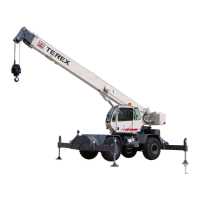Cold Weather Package Recommendations
For the operation and maintenance of your crane in cold weather, the information will cover
from 0° C (32° F) to -40° C (-40° F). When you operate your crane in temperatures above 0°
C (32° F), refer to your Terex Crane Operator’s & Shop Manuals.
Make sure you read and understand the information in
Cold Weather Package
Specifications on page 124 on the Cold Weather Package requirements for operations to
-40°C (-40°F). If your crane does not have this package installed, use the information in this
document as a guide to properly setup, operate and maintain your crane at these cold
temperatures. Use of the fluids recommended and installation of the specific heaters can
be ordered from your Terex Parts Department.
Install the correct lubricant in each area of the crane, engine, hydraulic tank, fuel, axles,
bearings, bushings, winches, swing drives and steering fluid.
All batteries should be fully charged and electric blanket plugged in to correct voltage source.
Fill the fuel tank at the end of each shift.
Check the air cleaner and air intake daily. Keep any snow clear of the air intake.
When driving, your hydraulic steering gearbox can be slow to react to your steering wheel
movement due to the low temperatures, even with the lower viscosity oils.
If the engine is started, run the engine until the engine reaches operating temperature.
Achieving operating temperature will help prevent the intake valves and exhaust valves
from sticking.
The cooling system and the lubrication system for the engine do not lose heat immediately
upon shutdown. The transmission and the hydraulic system lose heat more rapidly because
of the exposed areas. Gear cases cool rapidly, since the gear cases do not operate as
warm as other components. Thus, the engine can be restarted after shutdown for a couple
of hours but the other systems will require exercising (cycling) upon starting.
Fluid Recommendations
Before attempting to start the engine, make sure that the oil in the engine, the oil in the
transmission and oil in the hydraulic system are fluid enough to flow. Check the oil by
removing the dipstick. If the oil will drip from the dipstick, then the oil is fluid enough to
start the engine. Do not use oil that has been diluted with kerosene. Kerosene will
evaporate in the engine. This will cause the oil to thicken. Kerosene will cause swelling and
softening of the silicone seals.
If the viscosity of the oil is changed for colder weather, also change the filter element. If the
filter is not changed, the filter element and the filter housing can become a solid mass.
Drain all hydraulic cylinders and lines. After you change the oil per recommendations in
Cold Weather Package Specifications on page 124, operate the equipment in order to
circulate the thinner oil.
The number of acceptable lubricants is limited in arctic conditions and deviations of these
lubricants must be approved by Terex Service Department.
129P/N 12261-319 REVISED: August 2012
Courtesy of Crane.Market

